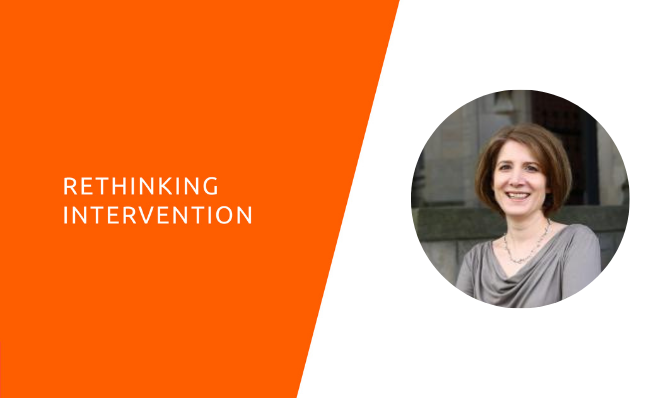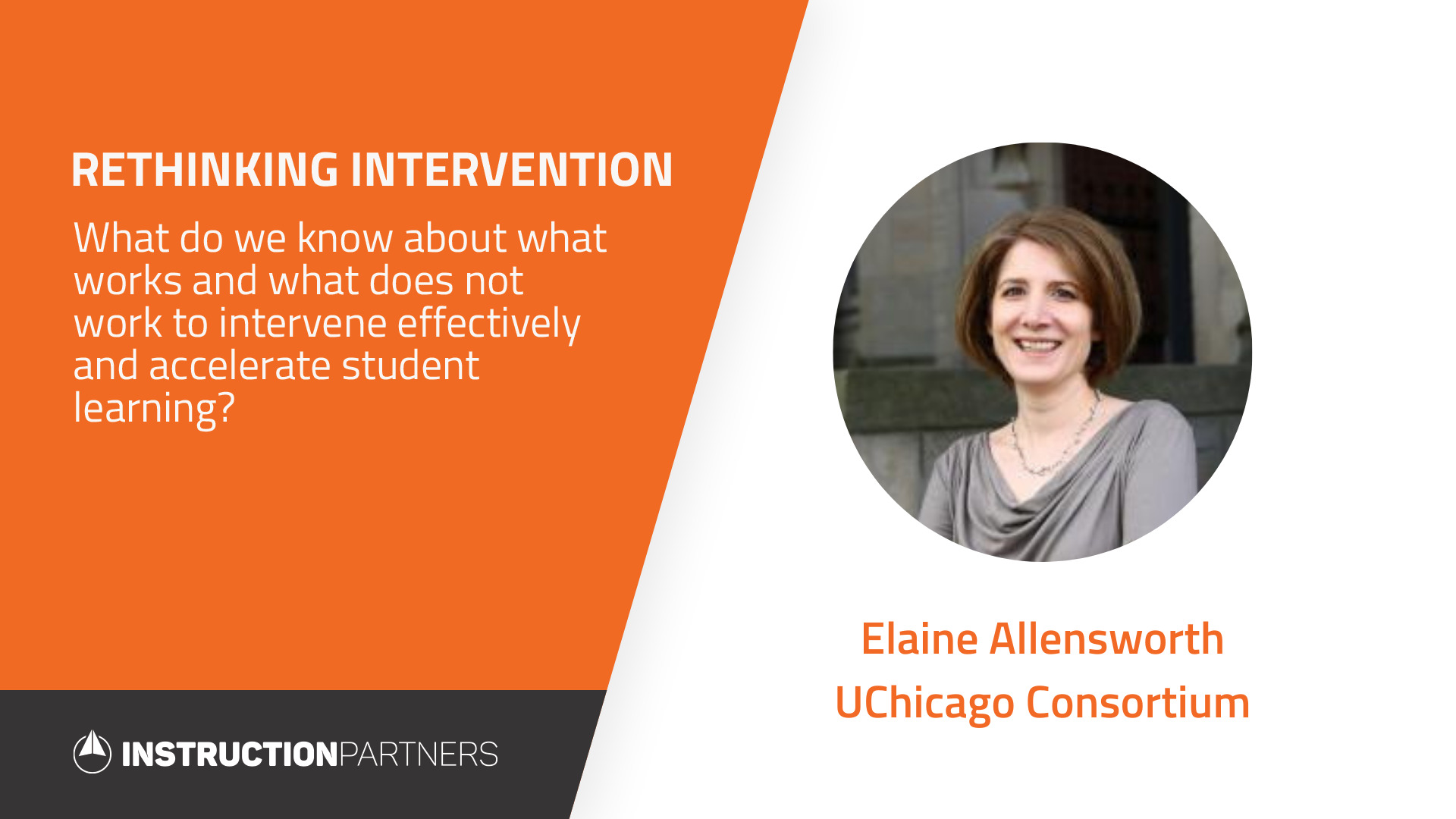EF: So when schools focused on test scores and strategies to improve test scores, it did not lead to improved test scores. But when schools focused on improving engagement and learning test scores went up—and is that like attendance and grades?
EA: Attendance and getting your assignments in. Basically, they would flag any student that was getting a D or F, because obviously, those students need more support. You want to do it as early as possible because when students have missed half their assignments, it could be really hard to catch up. Basically, if students are getting D’s or F’s, they’re not engaged, and they’re not learning anything. If your job is to teach that student, you are not succeeding. The way that your job is structured might have made that really hard. We tend to structure schools as if everything is perfect and all students can come to school ready to learn every single day, and if they don’t then that’s not the teacher’s problem or the school’s problem, it’s the student’s problem. The thing is, we know that that’s not how life works.
EF: Especially in a pandemic.
EA: We know that people don’t have the resources to get to school every day with clean clothes and food. We know that that is not the case, and yet we structure our schools as if it is. Even if you talk to families with a lot of resources, they will talk about all the extra resources that they’ve put into their children. If a child is suffering from anxiety and the child needs a psychologist or a doctor, or if their child needs a tutor, they have the resources to get the extra support that their child needs. Not all families have that, even though we know that all families need those things. We have this system that’s structured as if everyone is perfectly fine, everything’s perfect, and they’re ready to go every single day. And that is not reality. The fewer resources you have, the harder it is to begin to meet those demands.
We also found that missing five days in the fall semester in ninth grade lowered your probability of eventually graduating high school by something like 20 percentage points. Five days. It’s basically a week, it doesn’t even seem like much. The problem is that it adds up. You don’t know when you’re going to miss something that’s really important and you’ve just fallen further behind.
EF: There’s a causation vs. correlation question there.
EA: Schools started keeping track of when students started having absences or missed assignments, and they started reaching out to those students early. We wondered if there are other things that are causing lowered attendance or causing students not to get their assignments done that also influence graduation. Those things will still exist, so we thought we’re not going to see this perfect relationship. We thought you might fix attendance and grades, and then they still don’t graduate. That what we thought would happen, and that is not what happened. As schools work more on improving attendance, improving student engagement in classes, getting their work done, and getting grades up, there was a direct correlation to not only passing classes but eventually graduating.
EF: And test scores as well?
EA: Test scores went up too, which we did not know would happen. You could hypothesize that it would happen, but people actually thought the opposite would happen. In general, people were very resistant. The thought was that if you focus on students who are the least engaged, you’re lowering your standards. Then there’s the idea that you’re going to keep more students in school and have students who are the low achievers in the class come into school more, and that’s going to make it worse for everyone. Actually, the students are coming to class anyway and have not been engaged, and being behind actually does slow down the class. When you give students who are struggling extra support, it helps everybody.
EF: Take us into what you found worked. What kinds of support moves led to better attendance and work completion?
EA: You have to structure it in ways that support adults to support students. It has always got to be with the student as the focus, but you’ve got to figure out systems for adults to support students. We know teachers have the responsibility to make sure their students succeed. What usually happens is teachers will say things like, “If you need help, come see me after school or at lunch.” First of all, students don’t come for help when they need it. You’re leaving it up to the student, and then you’re having teachers figure out what to do on their own when they have no extra information. That approach isn’t successful. You actually have to have structures that are set up where teachers and other staff in the school are working together and they’re looking at data on students. You always have to make sure that what you’re doing is actually having a positive effect on students because a lot of this is coming up with things that work for your school and work for you and making sure you have buy-in. It’s focusing on the data on how students are actually doing, and on if what you’re doing is actually making a difference.
EF: Almost like a continuous improvement practice?
EA: Right. For example, in ninth-grade team meetings, a student might only be flagged in one class, and look at what their attendance and their grades are like their core classes. Although, we did find that non-core classes matter just as much as core classes. Gym, art, all those things matter.
EF: Hold on. So attendance and completion of assignments in non-core classes mattered as much as in core class?
EA: It does, yes.
EF: Wow. Super powerful.
EA: The On Track Initiative is focused on the core classes. In some cases, a student might just be struggling in one class but not struggling in their other classes. So in those cases, the teacher in the class where they’re struggling can learn how to help that student be successful from other teachers. Or maybe there’s one class where the student is successful and that teacher understands something about that student that can help the other teachers.
EF: Did you find that there was a structure to these meetings that was needed?
EA: Structure is important, and you need to have a facilitator. Sometimes it can be difficult conversations, and in those situations, the first thing you’re going to do is start blaming students. Having someone who can have positive conversations will keep the focus always on how we can help the student. Another structure that some schools use is to have on-track coordinators who are non-teaching staff members. The on-track coordinators would get the reports and then they would look at classes where students are getting a D or F and bring in the teacher, the parent, and the student to try to figure out what’s going on, and then come up with strategies together. Another thing is that there might be students who are struggling across all their classes. In that case, it’s time to figure out what’s happening with that student and if there are other supports that need to be brought in. A lot of students will have things externally that they’re really struggling with but they’re embarrassed to talk about. It’s a matter of trying to figure out what is happening with the student and how we can support them, and that’s beyond what anyone teacher could do. So once you see that this is not just a problem in one or two classes and this student is really struggling, let’s figure out how we reach out.
EF: I’m just taking myself back into my own classroom. And I’m sort of puzzling. I’m like, why isn’t this ubiquitous?
EA: I was a teacher, too. There’s so much focus on going through your content. I remember I taught summer school one time, and it was mostly students who failed the year before and then a few students who were trying to get ahead. It’s a very compressed time, so if a student missed you had to call home and find out what was going on. As a teacher in the school year, I had never called parents. And I was required to do this. And I remember there was one student who’s like Mr. Tough Guy, and I had to call his mom. So, I called his mom and she started talking and I realized I had her as a student in my night class. I was teaching ESL at night, and she was one of my students there. I realized I knew her and we had a connection. He never missed a single day after that, and he became much attentive. I was like, Oh my god, why was I not calling parents before?
EF: And why didn’t the system make it happen?
EA: It forced having a policy where you had to log calls. We did this study to see what’s happening in ninth grade here. Why are some schools more successful than others? There’s this one school whose Ninth Grade On Track rates are much higher, their graduation rates are higher, but if you look at eighth-grade test scores they were just slightly below the district’s average. So what was going on with the school? The principal was very, very strict about attendance. All parents had to sign a thing before the school year that says, “We will not take students out for trips, that students will come every day.” If a student didn’t come to school, for every class that that student missed, the teacher had to call home and log the call. If the parents thought the student was in school, they would send someone out to try to find the student. Parents would be getting multiple calls a day, so immediately it sends a message to students that you’re not going to skip and fall behind. And you’re making that connection with the parents.
EF: Take us now into COVID. Policy leaders and school leaders are trying to figure out, What does attendance even mean if you’re in a totally distance setting? What do you think are the lessons for this time?
EA: I think that all of the things I just said are even more important. Teachers are going to be relying on parents. It’s about family communication, really reaching out to students to understand how they’re experiencing things. Without having the students in front of you, you have no idea unless you’re actually talking to students, or talking to parents for younger children, to find out how they’re engaging. Also, the students are going to have very different settings to engage in learning in terms of the access to technology, in terms of space, in terms of time, in terms of the ability of parents to provide support. It is all going to be so variable and then not to mention, the stress from the pandemic and from the economic fallout of the pandemic. That communication is going to be really key. But I think you can still use the same general principle of looking at assignment completion to see if students are getting their work done and that they’re engaged. You want to make sure that they’re not feeling overstressed, that they feel like they have support, and that it’s work that they feel like they have some interest in. But what you really want to make sure is if students are not getting any assignment that you understand why. Then you can problem-solve with family members about whatever those issues are or with other teachers. Trying to figure out what it is the students need so they get the resources to engage in school. Another thing is, a lot of people right now are saying that there’s just a lot going on. We have got to be careful. You have to be understanding that people are not going to be able to engage as usual, that students, teachers, parents are going to be under stress. But you also don’t want to give up on students and families.




